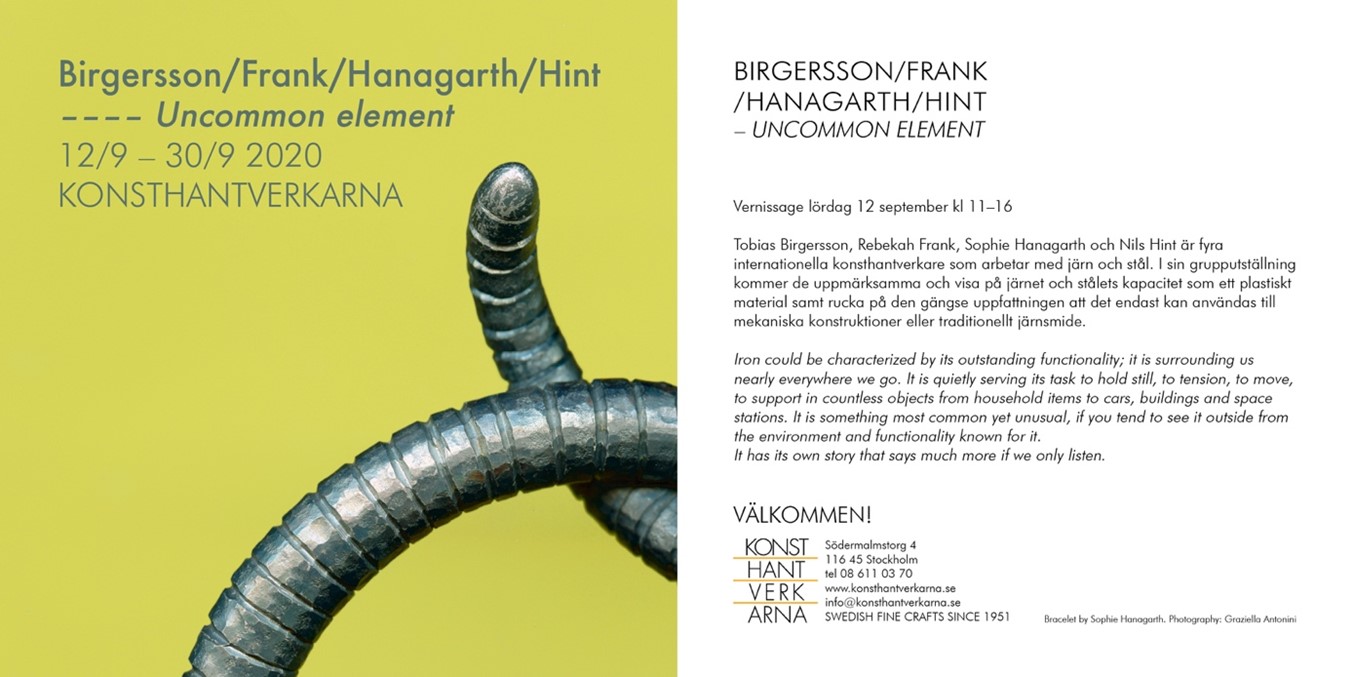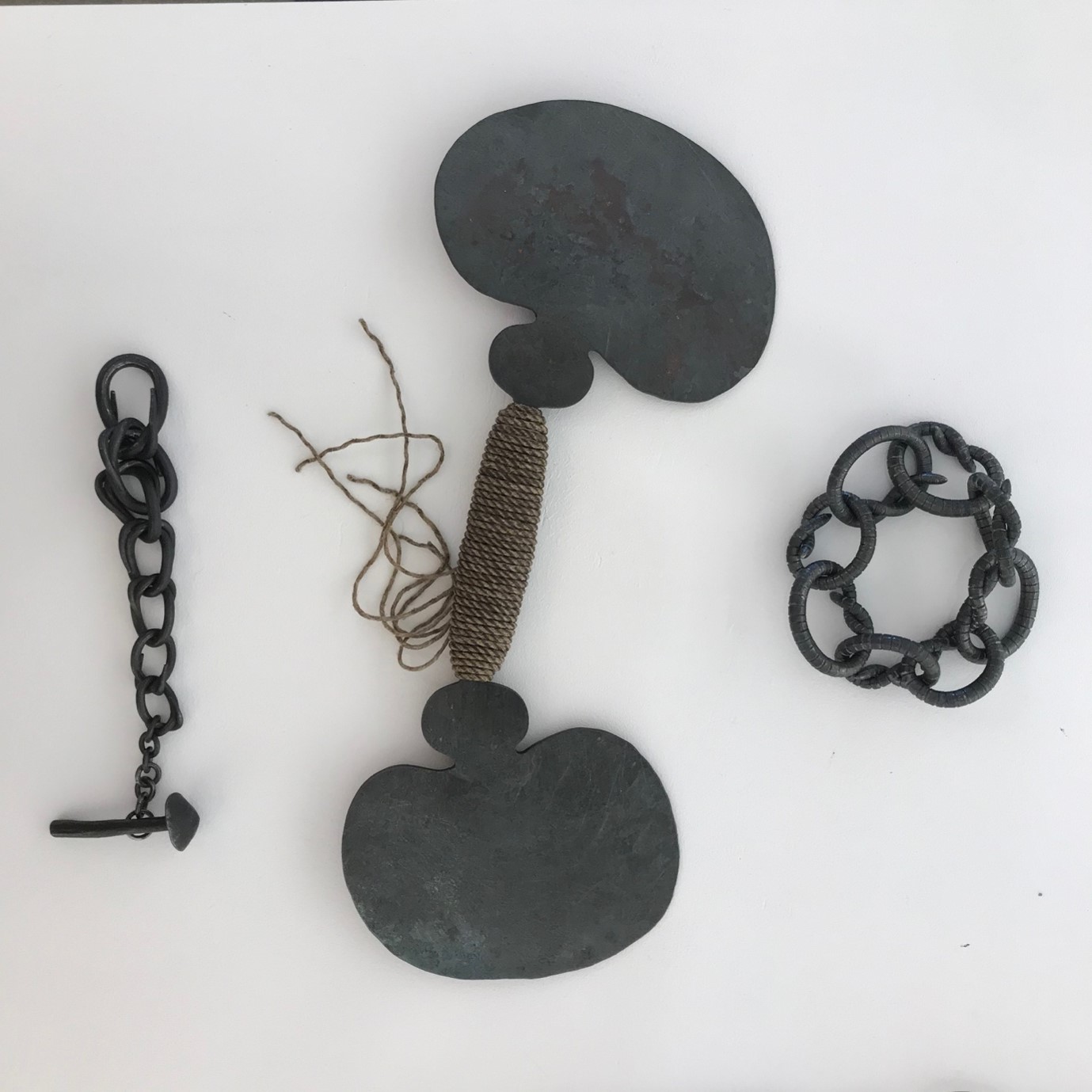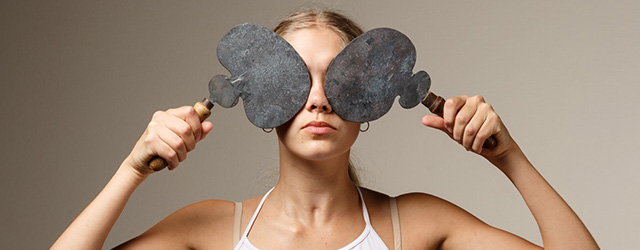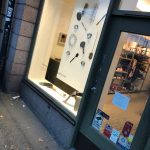Exhibition Uncommon Element open 12th-30th September 2020.
Tobias Birgersson, Rebekah Frank, Sophie Hanagarth and Nils Hint are four international metal Crafters that use Iron as their chosen material. Through this group exhibition they will highlight the material Iron and it´s plasticity as well as sidestep the norm that Iron and Iron alloys are meant solely to be used for mechanical construction or traditional Forging.
Iron could be characterized by its outstanding functionality; it is surrounding us nearly everywhere we go. It is quietly serving its task to hold still, to tension, to move, to support in countless objects from household items to cars, buildings and space stations. It is something most common yet unusual, if you tend to see it outside from the environment and functionality known for it.
It has its own story that says much more if we only listen.

Invitation Card to the echibition Uncommon Element.
Anders Ljungberg, professor at the BA program Ädellab and the MA program Craft at Konstfack – University College of Arts Crafts and Design, Stockholm, Sweden. Anders was involved in Gallery Konsthantverkarna and their exhibition group, over a year prior to the exhibition he approached all of us individually with the gallery´s initiative to create a group exhibition with focus on materialbased artists working predominantly with Iron and its alloys.
Anders and the board wanted to highlight the forging of Iron and the plasticity of the material and not focus on the fabricated steel. To most people Steel and Iron will be synonymous with hard constructions as well as forms when, in reality the metal is malleable and can be verry soft. The Gallery wanted to exhibit Jewelry as well as objects made from Steel. The key word was “Plasticity” and nontraditional forging. They wanted to show what the material can be and not how it is usually shaped.
Following this thinking they approached the four of us and we all accepted despite the fact that most of us had never met each other. It was supposed to be a perfect opportunity to collaborate on an international level – Nils Hint (Estonia) Sophie Hanagarth (Switzerland/France) Rebekah Frank (USA) and Tobias Birgersson (Sweden). Covid-19 put a stop to this. The Gallery Manager Hanna Grill and I curated and shaped the exhibition instead of the intended four artists.
The Curatorial plan was to mix all four artists as far as possible to let the pieces interact, when their makers could not. Hanna and Tobias worked to find the pieces that communicated with each other. The Grand Bazar meets the White Cube.

Pieces by Sophie Hanagarth and Tobias Birgersson.
Tobias Birgersson´s Contribution to the exhibition Uncommon Element
Tobias Contribution to the exhibition Uncommon Element was a series of smaller handpieces connected to the body and specifically the hand as well as a Tool rack wall piece. The handles to this series all come from old or really old favorite tools of mine, this enhances the link to tools as well as a sensory reminder to the user of a generic tool.
Anders Ljungberg stated in his Opening talk “Jewelry needs a body, and the tool needs hands”. I am interested in what kind of body and hand interacts with my pieces and how this change how the piece is perceived, by the viewer.
To investigate these ideas I have, in the past, been collaborating with photographer Christian Habetzeder. I chose to work with him again, this time with a young girl, Leia Birgersson, instead of the normative Tool user body that I have been investigating in previous projects.
Reflection
During the exhibition we, the exhibitors, were meant to each hold an Artist Talk on sight at the Gallery. Due to the Pandemic this did not happen, instead Rebekah Frank had her Zoom Talk from a burning California, and I was on site giving an Artist talk for eight people in the gallery and over 160 viewers over livestream. I had to interact with the other artists more than I would have if they had all been in Stockholm to be able to understand what they wanted to say with their pieces.








